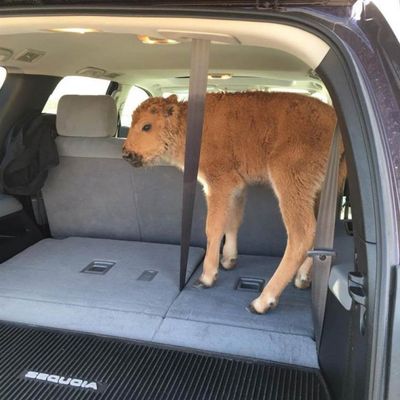
Over the weekend, a weird wildlife story was seemingly everywhere for a moment. A pair of tourists in Yellowstone National Park pulled up to a ranger station with a baby bison in their SUV, demanding to speak with a ranger. The calf, the father and his adult son insisted, looked cold, and so they had put it into their vehicle for safekeeping.
By Monday, the ridiculous story had turned sad: The calf had died. “Interference by people can cause mothers to reject their offspring. In this case, park rangers tried repeatedly to reunite the newborn bison calf with the herd,” according to a statement posted to the Yellowstone Facebook page. “These efforts failed. The bison calf was later euthanized.”
In a way, the SUV incident helps illustrate the tricky balancing act of anthropomorphism, in which scientists who study animal cognition are currently engaging. In recent months, prominent biologists have argued that assuming that animals experience the world much like humans do is often a better place from which to start than the opposite — that is, the assumption that their experiences on Earth are nothing like ours. Earlier this year, a new scientific journal launched called Animal Sentience: An Interdisciplinary Journal on Animal Feeling; it is specifically devoted to the study of animals’ inner lives. (First order of business: Do fish have feelings?) This is quite a dramatic shift in thinking within the scientific community considering the fact that just a few decades ago, asking the mere question of animal sentience was enough to potentially ruin a career. (This is, incidentally, almost exactly what happened to Donald Griffin — the biologist who discovered bat sonar — when he published a book in the 1970s titled The Question of Animal Awareness.)
And so, on the one hand, scientists like Frans de Waal — the famed primatologist who just published a new book, Are We Smart Enough to Know How Smart Animals Are? — must argue the point that anthropomorphism isn’t necessarily a bad, unscientific thing. And yet at the same time, he told Science of Us in a recent interview, he worries about the other extreme: People who take this idea too far, and apply a human perspective where it absolutely doesn’t belong, like in the case of this poor baby bison in Yellowstone.
This is at least partially the fault of the proliferation of gee-whiz animal viral videos that crowd certain corners of the internet, de Waal said. “I find myself in the odd situation where I now need to put a brake on it sometimes,” de Waal said. “On the one hand, it’s good — all these videos on the internet, in the sense that instead of me telling you just an anecdote about what happened, I’m going to show you what happened.
“So if a dog rescues another dog, or if a dolphin rescues a human swimmer, we now have videos of that kind of stuff, which is truly remarkable, and strengthens, of course, the argument that there’s more going on than we used to assume,” he continued. “But then people also say things that I really have trouble with.” Taken individually, these sorts of wrongheaded interpretations about animals — they’re just like us! — are at least benign, even if they’re dumb.
A video that recently caught de Waal’s eye shows a dog who is splashing water over a dead fish; headlines about the video said things like “Watch a Dog Desperately Trying to Keep A Fish Alive.”
“People were concluding that the dog was trying to save the fish, and understood that the fish needed water,” de Waal said. “I’m not convinced. I’ve seen so many times dogs trying to cover up things that smell — as soon as something smells bad, they’re going to dig and throw dirt over it. And to me it looked like the dog was trying to cover some bad smell there.”
Or there was Koko the gorilla, the star of a YouTube video uploaded earlier this year, which features Koko signing a supposedly impassioned message to humanity about climate change. “It was clearly a trained performance,” de Waal said. “I don’t think Koko has much of a concern for climate change.”
Again, as one-offs, these examples don’t pose too much trouble. But taken as a whole — this is where the trouble can come, potentially morphing into “misplaced concern” for bison calves in national parks who are doing just fine on their own, thanks. “People fall for these things because they like to read things into animals,” de Waal said. “So it’s almost a balancing act. I think anthropomorphism is not bad, but you do want to apply some judgment.”
Either extreme — assuming animals are just like us or assuming that they are not anything like us — fails the test of something you might call cross-species empathy; in other words, both are mistaken ways of understanding animals because they fail to take the animal’s perspective into consideration. “The human obsession of the last century has been, ‘How do they compare to us?’ It has always been on our terms,” de Waal said. It’s more helpful, and usually more accurate, to try to see the world from their perspective. Sometimes, that looks a lot like ours; sometimes, as in the case of this little bison, it does not.




